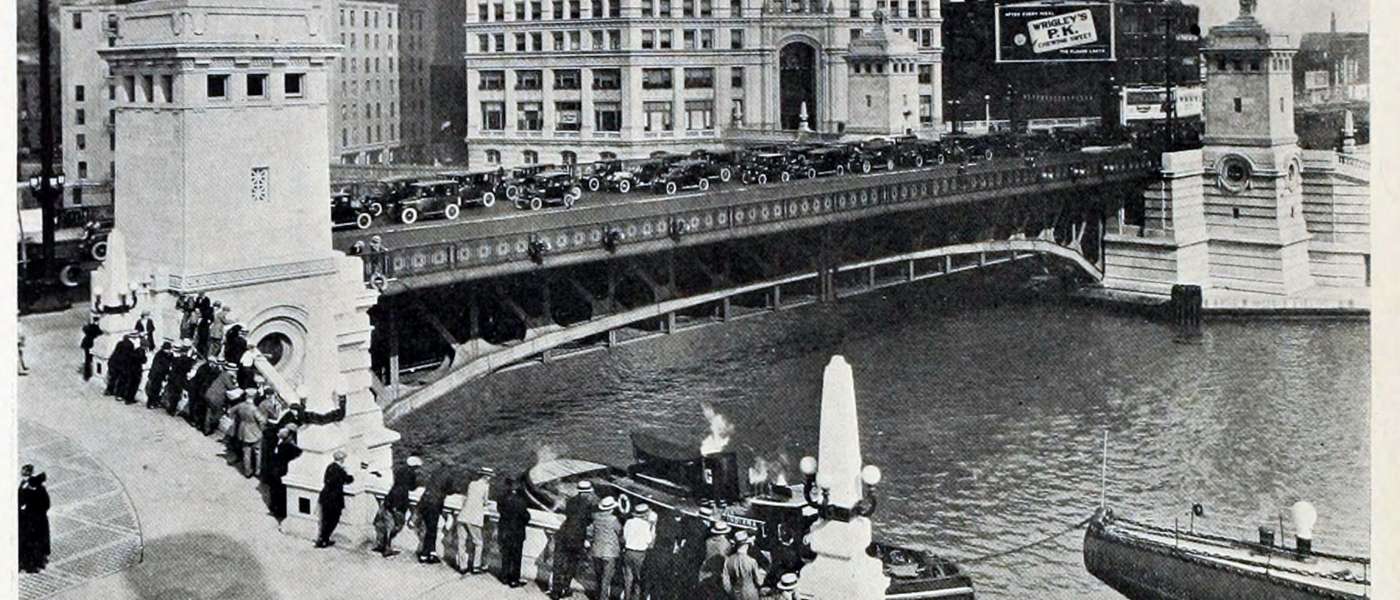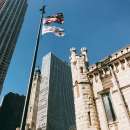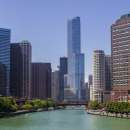Who Founded Chicago?
The DuSable bridge connects Michigan Avenue to the north and south and commemorated its 100th anniversary on May 14, 2020.
When the DuSable Bridge opened on May 14, 1920, 10,000 vehicles drove over the Chicago River to celebrate former Mayor Thompson's birthday. The bridge transformed a single dirt-lane road known as Pine Street into The Magnificent Mile in downtown Chicago that we know and love today.
Formerly the Michigan Avenue Bridge, it was renamed in 2010 in honor of the "Father of Chicago," Jean Baptiste Pointe DuSable, a French Haitian and the city's first non-native settler.
The centennial provides hope during the COVID-19 pandemic. Chicagoans completed this monumental project in the wake of the Spanish Flu, ushering in decades of progress.
As Mayor Lori Lightfoot says, we have a lot to look forward to on The Magnificent Mile in the next 100 years!
In the meantime, read below for more history, fun facts and expert perspectives.
Chicago's Next Big Moment
A conversation with Lynn Osmond, President and CEO, Chicago Architecture Center.
"Chicago is a city that continues to innovate. We've shown our grit before to the world as we built the World's Fair in 18 months, rose from the ashes from the Great Chicago Fire, and built the first skyscraper. We are a city that continues to reinvent ourselves. We have the talent and innovation in Chicago, and I'm excited to see how we use that going forward."
-
The DuSable Bridge is defined by the four bridgehouses that were completed in 1928 and depict four pivotal moments in Chicago's history:
- The arrival of French Explorers
- The first permanent non-native settler, Jean Baptiste Pointe DuSable and John Kinzie
- The Battle of Fort Dearborn
- Rebuilding after The Great Chicago Fire
People are encouraged to see these and explore. The Chicago Architecture Center offers virtual tours offering more insights into these bridgehouses that anchor The DuSable bridge on all four corners.
Fun Facts
- Leaf weighs: 4,100 tons
- Counterweights that make the bridge go up and down weighs: 12,000 tons
- In the 1920s, the bridge rose 3,000 times per year; today, it lifts approximately 50 times per year
- 3,800 vehicles go across the upper deck; 11,700 vehicles go across the lower deck
The DuSable Bridge: A Monument in Motion
A conversation with Josh Coles, Director, McCormick Bridgehouse & Chicago River Museum.
"The DuSable Bridge and the bridgehouses are built in the Beaux-Arts style. The bridge is the first double-leaf, double-deck, bascule-style bridge. The double-leaf means each side of the bridge is a leaf and is split in two. They are essentially two bridges next to one another. The lower level helps hide commercial traffic out-of-view and provide the upper deck for a more pleasant experience for pedestrians and vehicle access."
-
Fun Facts:
- "Bascule" translates to something similar to a see-saw, which conveys the incredible balance these bridges have with a counterweights system.
- Whenever the bridge moves, the counterweight moves down and the leaf rises.
- Approximately 110 horsepower is all it takes to move tons of steel.
- The Chicago Department of Transportation manages the efficient process of lifting the bridges. The most popular time of year for the bridge lifts is when sailboats exit the harbor downtown on to Lake Michigan.
- The McCormick Bridgehouse & Chicago River Museum offers up-close views of the gears that move these tons of steel
The McCormick Bridgehouse & Chicago River Museum provides a one-of-a-kind opportunity to explore a historic landmark bridgehouse. At river level, visitors can view the massive gears of Chicago's most famous movable bridge and then journey through time as they experience the story of the Chicago River. Once at the top of the Bridgehouse, visitors are treated to magnificent 360-degree views of the city and river and will gain a whole new perspective on the beauty and complexity that is Chicago.
The Bridgehouse Museum furthers the mission of Friends of the Chicago River.
DuSable Bridge: The Gateway to The North
A conversation with Grant DePorter, CEO, Harry Caray's Restaurant Group.
"I love Chicago history. I think I have the largest collection of newspapers going back to the 1800s. In 1909, the DuSable Bridge was part of the master urban planner's vision, Daniel Burnham."
-
Q: What was going on during the construction of the DuSable Bridge?
"They built the bridge while the Spanish Flu was happening in 1918. Prohibition started in 1919, and people couldn't legally have alcohol. Years later came the Great Depression (1929-1933), and progress in this district was put on hold for a bit."
Q: How did this 'Gateway to the North' open on May 14, 1920?
"When the bridge was completed in 1920, it was a visual treasure. It was the center of attention. More than 10,000 vehicles crossed the bridge in celebration."
Q: When did The North Central Business District get involved with Michigan Avenue urban planning?
"The North Central Business District Association, what is now The Magnificent Mile Association, was formed in 1912. This group of business leaders formed to take over The Burnham Plan vision and lay the groundwork to make Michigan Avenue one of the Great Avenues of the World."
Q: Do you have other historical records that share any additional insights?
"I recently looked at the historical documents from my building at Harry Caray's that was built in 1895. Records show the history and tax levies from 1919, that were designed to help support the costs for the construction. Everyone paid to make it a reality. From these records, I saw the former building owners paid their share!"
Q: Who coined the phrase "The Magnificent Mile"?
"Real estate developer Arthur Rubloff of Rubloff Company coined the phrase "The Magnificent Mile" for this business district in the 1940s. He helped set the groundwork for what we know as one of the Great Avenues of the World."
Chicago Then: An Algonquin Area Called Shikaakwa
In conversation with Heather Miller, enrolled member of the Wyandotte Nation from Oklahoma, and Executive Director of the American Indian Center of Chicago.
"[We represent] one of the oldest urban Indian Centers in the country dating back to the 1950s. Our mission is to promote fellowship among Indian people of all Tribes living in metropolitan Chicago and to create bonds of understanding and communication between Indians and non-Indians in this city. To advance the general welfare of American Indians into the metropolitan community life; to foster the economic advancement of Indian people, to sustain cultural, artistic, and avocational pursuits; and to perpetuate Indian cultural values."
-
Q: Can you help describe what Chicago was like for the original inhabitants?
"There are a variety of different answers, but what we now know as Chicago was a communal area because of the rivers, waterways, and prairies. It provided a lot of resources for tribes and wasn't one tribe's homeland. It brought people together.
In fact, "shikaakwa" means “striped skunk” or “smelly onion." It's always been a place people came to because of the resources here. We know that at one time the folks were involved with the Ottawa, Ojibwe, and Potawatomi (Council of Three Fires) would have been the real caretakers of this land. They would have been the original inhabitants of Chicago. It truly was a place that was shared by a lot of tribal people that encouraged the gathering and respect of beliefs."
Q: Anything you'd like to share about your hopes for the future?
"One of the things we constantly do at the American Indian Center is to bring awareness and visibility to our community. Many people are surprised to learn that 80 percent of American Indians live in urban areas, and approximately 20 percent live on reservations.
We constantly uplift and talk about issues that impact the native community here in Chicago, trying to help share our history. We know how to be resources to help heal this land."
Q: What can you share as we get through this time and pause and be better caretakers?
"As we move forward into this next phase, I think it's so important for us to think about our relationships. First and foremost, this isn't just a relationship between human beings; it is a relationship with our entire way that we walk in this world. It is our relationship with our plant brothers. It is our relationship with our animal sisters. It is our relationship with the water, and with the air. And so, while we're pausing from what has been our traditional way of operating, this is a good time to rethink how it is that we walk with others. What is our relationship with the land and with the water? How can we be more respectful and see them as equal? Not see them as stewardship or ownership over, the more we can think about the relationships outside of our people relationships -- the better we can be. It's a good way to focus our energies as to what comes next."
Mission of the American Indian Center
- Today, the American Indian strives to be the primary cultural and community resource for nearly 65,000 American Indians in Chicagoland's six-county region. Chicago is the third-largest urban Native American population in the country, with over one-hundred tribal nations represented. With over 75% of all Native people living off-reservation and in urban settings, the AIC represents this emerging Native population shift, resulting in a diverse multi-tribal community in need of a common social and cultural place of gathering.
- Through a combination of short-term relief services and long-term education and support programs, we seek to foster physical and spiritual health in the community, an active connection with traditional values and practices, stronger families with multigenerational bonds, and a rising generation of educated, articulate, and visionary youth.
Chicago Now: A Foundation for Emerging Native Economies
In conversation with Andrew Johnson, Executive Director, Native American Chamber of Commerce of Illinois.
"When you look at it from a historical standpoint, several tribes have always populated the Chicagoland area. It has so many advantages to support a diverse population because of the rivers, the waterways, the Great Lakes. In the beginning, the rivers were the original highways. Chicago was named "Checagou" which translates to garlic or wild leeks. The plants in the area had a profound fragrance."
-
Q: What does the Native American Chamber of Commerce of Illinois do?
“NACC-IL's work is guided by the belief that Native businesses are a foundation for emerging Native economies that will provide employment and educational opportunities and allow our Native communities the opportunity to break the generational cycles of poverty. Today we carry that belief forward and continue to work toward a brighter future with a thriving and connected Native American community that empowers its business leaders with resources, partnerships, and services that ensure their success and supports the aspirations of community members.”
Q: How long have you been involved?
“We began in the summer of 2017. We have never had a 'seat at the table.' To help people know we are a vibrant community. We have tremendous resources to apply to different opportunities. It's been very exciting to build this in Chicago and throughout Illinois. There is much yet to do and get a seat at the political and economic table.”
Q: Can you shed light on the role Native Americans played here in Chicago?
Jean Baptiste Pointe DuSable’s marriage to a Potawatomi citizen, one of the primary tribes in this area, allowed an opening for him to trade with many of the other tribes in the area. This helped form his friendly relationships with many tribes. This area was a significant point for the trade of goods.
What was difficult in the 1800s was the conquest and ultimately the Chicago Treaty of 1833, which was considered one of the final points of removing Native Americans. The Potawatomi did not sign this agreement and were able to stay and thrive in this area.
During this time, there was tension. There were wars. It was very difficult.”
Q: How many Native Americans live in Illinois?
When you look at Illinois as a whole, the Native American influence was removed with the Chicago Treaty of 1833.
- In 1917, approximately 10,000 Native Americans served in World War I
- In 1920, the U.S. Census listed 94 American Indians
- In 1930, the U.S. Census listed 246 Native Americans
- In 1924, Native Americans were not considered U.S. Citizens
- In the 1950s, several federal acts under the Truman Administration terminated treaties and relocated Native Americans in a negative way (1953: Congress seeks to abolish tribes, relocate American Indians. Congress passes a resolution beginning a federal policy of termination, through which American Indian tribes will be disbanded and their land sold. 1956: The Indian Relocation Act of policy of “relocation” moves Indians off reservations and into urban areas.)
Today, about 80% of Native Americans live in urban areas, and about 20% live on reservations. There are 100,000 in the Chicagoland area.”
Q: Can you share the symbolism of your logo?
“The logo of the Native American Chamber of Commerce of Illinois is a trail marker tree. The artist is Dennis Downes.
Native Americans have an oral history, and when that is interrupted, you miss those connections. The trail marker trees marked particular trails, water, fertile land and sites of significance. They used to be quite numerous. It is a reminder for us to move forward.”
Q: Are there ways people can help?
“The pandemic has hit us very hard. One of the areas hardest hit is artisans who have learned and developed their tribal artistry. Primary markets are with festivals, and given what we're going through in Illinois, the Chamber will be sponsoring an online store for these artisans from around the Great Lakes.”
Q: As we celebrate the DuSable Bridge's 100th Anniversary, what is your hope for the next 100 years?
“Our hopes and aspirations for the next 100 years are to continue to grow and have an active seat at the political and economic table, to build the entrepreneurs of tomorrow. Having a Native American mayor or governor and other elected officials would be an absolute joy for us. To see Native American entrepreneurs grow and develop their businesses. And to give back, to take care of the earth and our environment. Ensure we are a community with nature with the water with the lakes and our environment. That is what we would like to see."








